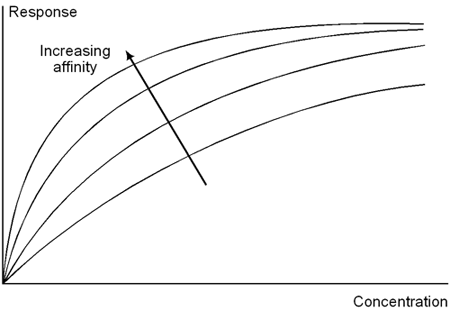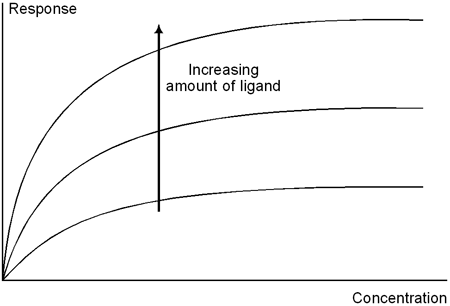Biacore X100 reference portal
Operating range for direct binding assay
The typical shape of the calibration curve for a direct binding assay is shown in the picture. The lower limit of the operating range is set by the noise characteristics of the assay at low response levels. The upper limit is set by the shape and position of the standard curve in relation to analyte concentrations, since the sensitivity (precision) of the assay decreases with increasing concentration.
- The affinity of ligand for analyte affects the position of the curve on the concentration axis. As an approximate guideline, half-maximal response is obtained when the analyte concentration is the same as the affinity constant for the interaction (KD) if the interaction is allowed to proceed to equilibrium (this is precisely true for 1:1 interactions and can be taken as a first approximation for most interaction-based assays).

Using a ligand with a higher affinity moves the calibration curve towards lower analyte concentrations - The amount of immobilized ligand affects the height of the curve on the response axis: a higher level of ligand gives a higher maximum analyte response. Higher response levels will give greater precision in the measurements so that the range of the assay is extended but not shifted.

Higher amounts of immobilized ligand increase the response but have little effect on the shape of the calibration curve. - The contact time for the sample affects both the height and position of the calibration curve. If the response is measured before the interaction has reached equilibrium, the height will be reduced and the curve will be shifted towards higher concentrations.

Longer contact times allow measurement at lower analyte concentrations. The insert shows the sensorgrams from which the calibration curves are derived.
Enhancement reagents
For assays using enhancement reagents, additional factors influencing the range are the affinity, concentration and contact time for the enhancement reagent. In general, enhancement reagents should be used at relatively high concentrations (typically 10-100 µg/ml) to ensure rapid and complete binding with short contact times.
To optimize the range of a direct binding assay, determine a calibration curve to establish the approximate range of the assay and then use the principles described above to make appropriate adjustments. If the range requirements cannot be met by adjusting the contact time or ligand level, you will need to review your choice of ligand and possibly your choice of assay format.
Panel 2 header
Lorem ipsum dolor sit amet, consectetur adipisicing elit. Repellendus aliquid tempore natus voluptates repudiandae, eos dolorem libero inventore, quod incidunt, asperiores. Reiciendis itaque enim pariatur, blanditiis minima autem quo a nulla, obcaecati quis, excepturi atque ab rerum! Sequi molestias vel eum, hic, perspiciatis eius suscipit reprehenderit molestiae vitae similique.
Panel 3 header
Lorem ipsum dolor sit amet, consectetur adipisicing elit. Repellendus aliquid tempore natus voluptates repudiandae, eos dolorem libero inventore, quod incidunt, asperiores. Reiciendis itaque enim pariatur, blanditiis minima autem quo a nulla, obcaecati quis, excepturi atque ab rerum! Sequi molestias vel eum, hic, perspiciatis eius suscipit reprehenderit molestiae vitae similique.

Panel 4 header
Lorem ipsum dolor sit amet, consectetur adipisicing elit. Repellendus aliquid tempore natus voluptates repudiandae, eos dolorem libero inventore, quod incidunt, asperiores. Reiciendis itaque enim pariatur, blanditiis minima autem quo a nulla, obcaecati quis, excepturi atque ab rerum! Sequi molestias vel eum, hic, perspiciatis eius suscipit reprehenderit molestiae vitae similique.
Panel 4 header 2
Lorem ipsum dolor sit amet, consectetur adipisicing elit. Repellendus aliquid tempore natus voluptates repudiandae, eos dolorem libero inventore, quod incidunt, asperiores. Reiciendis itaque enim pariatur, blanditiis minima autem quo a nulla, obcaecati quis, excepturi atque ab rerum! Sequi molestias vel eum, hic, perspiciatis eius suscipit reprehenderit molestiae vitae similique.
Panel 5 header
Lorem ipsum dolor sit amet, consectetur adipisicing elit. Repellendus aliquid tempore natus voluptates repudiandae, eos dolorem libero inventore, quod incidunt, asperiores. Reiciendis itaque enim pariatur, blanditiis minima autem quo a nulla, obcaecati quis, excepturi atque ab rerum! Sequi molestias vel eum, hic, perspiciatis eius suscipit reprehenderit molestiae vitae similique.
Panel 5 header 2
Lorem ipsum dolor sit amet, consectetur adipisicing elit. Repellendus aliquid tempore natus voluptates repudiandae, eos dolorem libero inventore, quod incidunt, asperiores. Reiciendis itaque enim pariatur, blanditiis minima autem quo a nulla, obcaecati quis, excepturi atque ab rerum! Sequi molestias vel eum, hic, perspiciatis eius suscipit reprehenderit molestiae vitae similique.
Panel 5 header 3
Lorem ipsum dolor sit amet, consectetur adipisicing elit. Repellendus aliquid tempore natus voluptates repudiandae, eos dolorem libero inventore, quod incidunt, asperiores. Reiciendis itaque enim pariatur, blanditiis minima autem quo a nulla, obcaecati quis, excepturi atque ab rerum! Sequi molestias vel eum, hic, perspiciatis eius suscipit reprehenderit molestiae vitae similique.